
views
Building Basic Skills
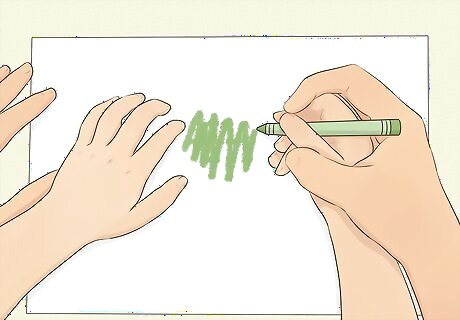
Teach the child how to hold a crayon the correct way. This can be taught before the child learns to read or write, such as when they are drawing with you. Start by holding the crayon yourself as an example. Then place the crayon in your child's hand and wrap their fingers around it correctly. Guide their hand to trace a shape or write their name. Show your autistic child how to do this as early as possible; most children are able to properly hold a crayon by age 4.

Try squeeze exercises to help them build muscle. Have the child squeeze objects (such as a stress ball or play-dough) to build finger strength. Start with very soft objects and gradually work your way up to harder ones as the child gets stronger. Play-Doh and clay can help with dexterity. Your child can also try tasks like watering plants with a spray bottle.

Improve the child's fine motor skills with art projects. Get art materials such as chalk, paints, markers, crayons, scissors, coloring books, and stamps. Allow the child to make art with the supplies, without any pressure to perform. For example, have the child thread beads onto a string to increase finger dexterity. This can be a good opportunity to spend relaxed quality time with the child. Let the child choose what they want to do, and do activities together.

Build strength by having them paint and draw on vertical surfaces. Working on vertical surfaces helps autistic children develop crucial wrist muscles needed for writing. Use an easel to encourage the child to paint or draw vertically. Magnetic and chalk wallpaper are also great for this.

Expose the child to the alphabet with simple techniques. This can help them learn about the letters. Let them play games related to the alphabet, and learn what sounds each letter makes. Foam puzzles where pieces are shaped like letters Alphabet fridge magnets or window clings Singing the alphabet song
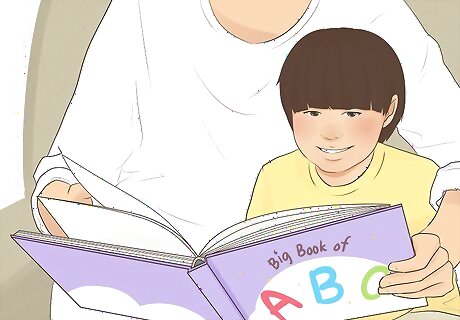
Read with your child to expose them to letters and words. Look for books about the alphabet, and books about subjects that interest the child. Let them follow along as you read so they can start becoming more familiar with letters, words, and language in general. Autistic children often have a hard time being still for stretches of time, so aim for short reading sessions. Let them see you reading too, and leave age-appropriate books lying around the house so they can pick them up anytime.
Doing Writing Exercises

Use a pencil grip to help with hand placement. If the child has difficulty holding a pencil, try using a pencil grip. There are lots of pencil grips to choose from such as a soft pad to place around the pencil, finger holes, or special pencils designed to encourage better grip. Try a few different kinds to see which ones the child feels most comfortable using.
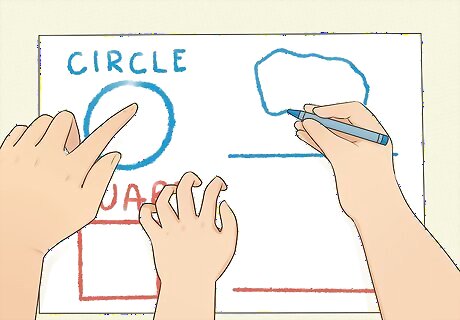
Ask the child to copy shapes and letters. Start by drawing lines on paper and then having the child copy the lines. Move on to simple shapes. Slowly work your way toward having them copy letters. Spend 5-10 minutes each day having the child copy your marks. Once they get to letters, let them use large pieces of paper with big lines.

Use touch to help form letters. Children who are touch-oriented may enjoy using certain textures to start writing. If the child is drawn to certain textures, use these textures to help them practice writing skills. For example, use finger paints or shaving cream as mediums to write with. Some autistic children are not comfortable with wet, slimy, or other textures. If so, don't push them to do this.
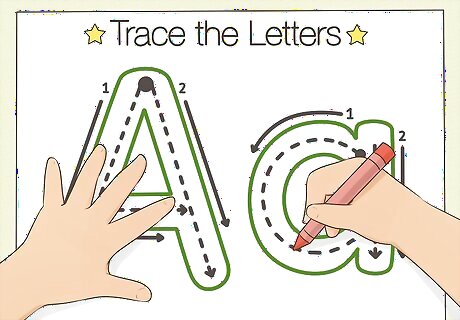
Print out worksheets so they can practice the alphabet. You can find worksheets online that your child can use to practice letters. Find some with big letters and spacious lines. Print the worksheets out and have your child work on 1 worksheet each day.

Write a word in large letters so they can see how it works. When a child is still beginning to write, it can help to have an adult model it. Write large letters in highlighter, and have your child trace it in pencil or pen. Let them connect the dots. Draw dots in the shape of a letter. When writing their first words, choose words they like, such as their name, names of their favorite people, and names of their favorite things. Allowing the student to see a visual representation of what you're doing can help them more easily understand what you're expecting of them.

Ask the child to write about their interests. If the child is learning how to write but struggling to stay interested, get their attention with their favorite activities. Ask them about their favorite activities and have them write about them. For example, if a child loves loves watching birds, have them write about their favorite birds and the different birds they've seen recently. Special interests are a perfect way to help a child be interested and engaged. For example, if your daughter loves dogs, she might like writing a story about dogs with you. If you'd prefer the student write about a different subject, try giving them a choice between 2 or 3 very specific topics
Making Writing Easier for the Child
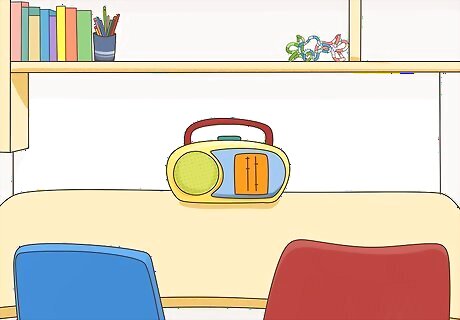
Take care of the child’s sensory concerns. Create a soothing environment that won’t be distracting or unpleasant for the child. This might mean playing soft music (or keeping a completely quiet atmosphere), adjusting the light levels of the room, and not having strong smells around.

Use aids when they are helpful. Some autistic children may respond better to pictures or sign language over spoken words. When giving directions to the child, use a visual aid or sign to help them know what to do next. If the child appears confused, use a visual prop to help explain. For example, have the child see a picture of a cat to help them visualize a cat while they write the word “cat.” Visual aids are also helpful if you're trying to teach the definition of a difficult word or concept. For students who are learning to write longer papers, consider using a graphic organizer, which is a visual representation of all of the parts of a paper, like the introductory paragraph and supporting details.
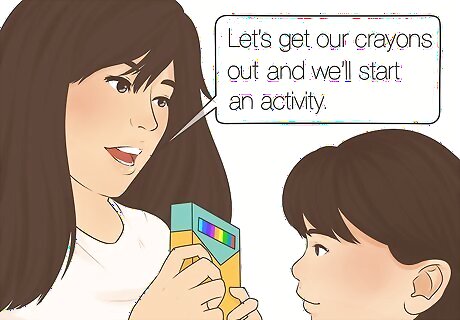
Give clear and concise directions. Autistic children may struggle to follow complex directions, so keep instructions short and brief. When introducing an activity, present one step at a time. Allow the child to follow your lead instead of giving all of the directions at once. For example, you can say, “Let’s get our crayons out and we’ll start an activity. First, let’s draw one line here.”
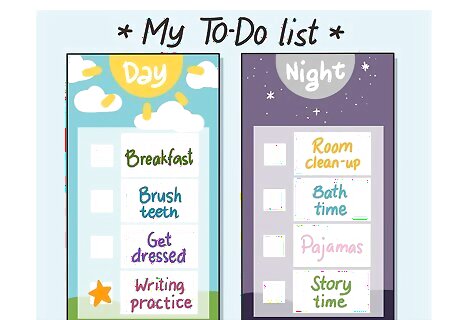
Add writing into the daily routine. Autistic children can thrive off the safety and predictability of a stable routine, so build writing into the daily schedule. The child may become more familiar with writing as it begins to be a consistent part of their day. For example, build a writing exercise into each day before or after lunch so that it becomes predictable. Don't pressure the child. If they don't feel like writing at a certain time, hold off for a little while. Present writing as a fun task rather than a chore.

Have fun together! Writing doesn't need to be a strict, rigid session. Goof around, be silly, and keep it fairly relaxed. Let the child bring a toy or two to the table, especially if they need to fidget in order to focus. If sitting down is hard, try giving your child an exercise ball or fidget-friendly seat cushion to sit on.

Schedule in breaks. If the child struggles to sit for extended periods of time, schedule in breaks so that they can get up and move around. Avoid pushing them too hard or for too long, since this may cause them to dread writing exercises.
Receiving Additional Help as a Parent

Create an individualized education plan (IEP) at school. If you live in the United States, schools are required to provide assistance to children who have documented learning problems. Call a meeting with your child’s teacher, the school psychologist, and other educational planners. Speak to them about giving your child the help they need to thrive. Your child’s school may offer services such as special education, a classroom aid, and additional help for reading and writing activities.

Work with an occupational therapist. An occupational therapist can help the child build skills needed for writing, such as fine-motor skills and muscle control. If your child attends school, they may qualify to see an occupational therapist while at school. You can also schedule an appointment with an occupational therapist through your insurance provider. Find an occupational therapist by calling a local health clinic or getting a referral from your child’s physician.

Seek out additional educational resources. There are lots of resources out there to help your teach your autistic child skills like writing. Join a local chapter of an autism group, for example. You can also attend workshops or classes at your local mental health center or community center.

Manage your expectations. It's normal and okay for autistic children to take longer with certain skills, and that doesn't mean you're doing anything wrong as a parent. Don't push your child or yourself too hard. It's okay to go slowly.

Reach out to other autistic people and their parents. Find a network online or in your local community to get to know other parents. Share stories, ask for advice, and support one another. You are not alone. Autistic adults remember their childhoods, including what it was like and what helped them best. Don't assume that a capable or well-spoken autistic adult is "not like your child." They may be very knowledgeable and may have had a difficult childhood themselves.

Get the emotional support you need. Parenting is always hard, and it can be especially hard when you have a child with extra needs, and you may deal with other adults' lack of understanding or unwillingness to help. It's normal to sometimes feel overwhelmed, stressed, or discouraged. If you're having a hard time, consider therapy sessions for yourself or your family.




















Comments
0 comment